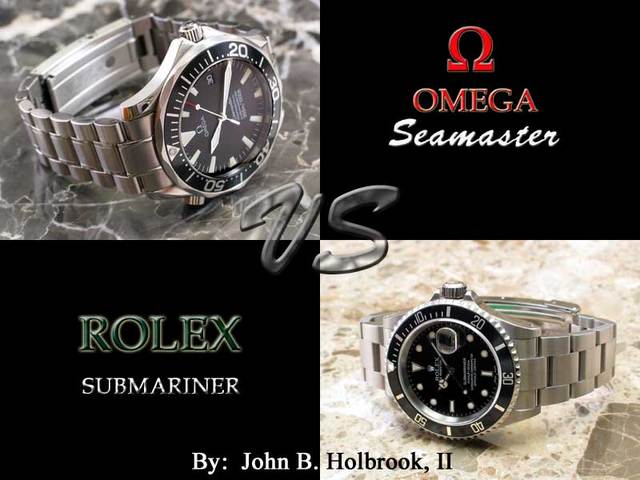
Comparative Review of the Omega Seamaster Professional Model 2254.50.00
VS. The Rolex Submariner 16610 Y Series
By: John B. Holbrook, II
June 7, 2003
One of the greatest company rivalries in horology is between Rolex and Omega. Both are well respected Swiss manufacturers of impeccable timepieces which are steeped in long histories and tradition. Each company also has their respective legion of loyal followers. So, naturally the question is often asked, "who makes the better dive watch?" Rolex? Omega?
Some would say that it's a fool's errand to compare two different watches - each has its own merits and should be judged accordingly. However, Rolex's Submariner and Omega's Seamaster lend themselves well for direct comparison in both form and function In particular, the Rolex 16610 Y Series, and the Omega 2254.50.00 are models that are easily and logically compared. I will attempt to compare each watch in both relative and objective terms.
Firstly, a word about the methods by which I'm using to evaluate these two watches, and my own personal biases. Firstly, I'm not weighting the categories in any way. Each category (bracelet, clasp, case, price, etc.) are an equal component of the final overall score. For some people, price, for example, is much more an important of a category than, say the clasp. Feel free to weight each of these categories with your own values to arrive at your own conclusions. Secondly, let me disclose that the Seamaster used in this article is my own, while the Submariner belongs to my good friend John Rigano. John and I hang out so much and talk watches, I practically feel like the Submariner's mine.. although he might not quite see it that way (NOTE: I do own one Rolex - a 1970 Oyster Precision). Let me also say that both of these watches are incredible timepieces - for me to rate one higher than the other doesn't at all mean that one or the other of these Swiss masterpieces is bad. On to the shootout!
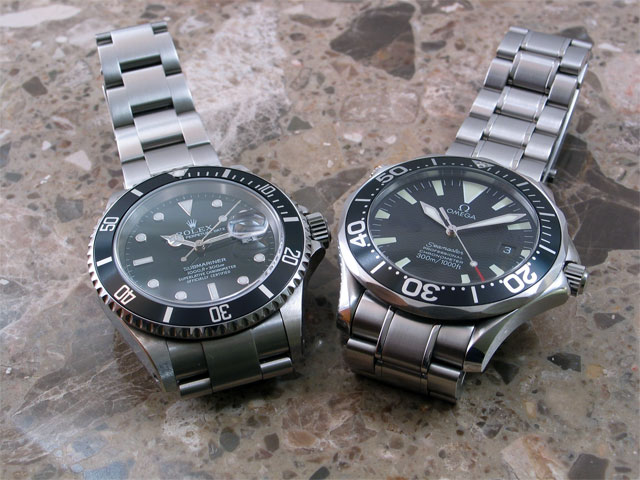
CASE
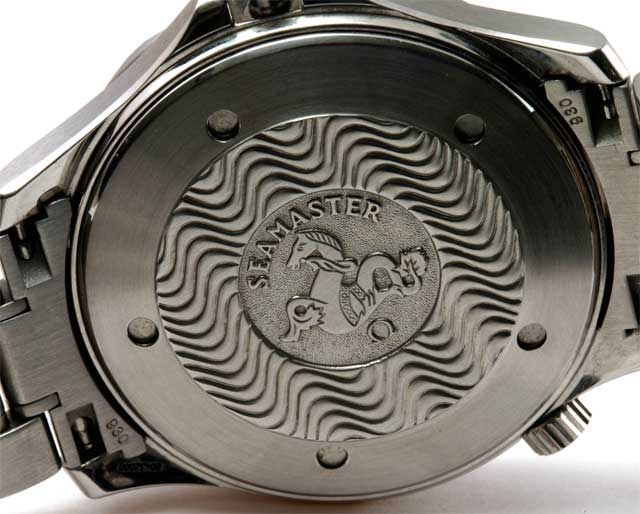
Seamaster: A perfect blending of form and function - 300 meters water resistant and absolutely gorgeous. A helium release valve is built into the case, making this watch particularly useful in extended time deep dives. The case has numerous angles and curves which vary the way light strikes and is reflected from the case. Yet, there are no sharp corners and it's completely comfortable. Of course, there's the gorgeous Sea Monster logo on the case back. I can find no flaw with this case. RATING: 10

Submariner: A simple, yet classic design which has been often copied. This watch is also rated for 300 meters of water resistance (but lacks a helium release mechanism - this feature is found on the Rolex Sea Dweller). Some users complain of uncomfortable sharp edges on the case. Like the bracelet (see my conclusion below on the use of 904 vs. 316L grade steel) the case is constructed from 904 grade steel. RATING: 9
Winner: The Oyster style case was the birth of the diving watch, but let us not forget that Omega was a pioneer in creating a water resistant (or water proof as was designated at the time) watches. The SMP's larger case size is a bit more impressive, as well as being more in step with the contemporary trend toward larger case sizes. The SMP wins out here in both comfort and cosmetic appeal: SMP
BEZEL
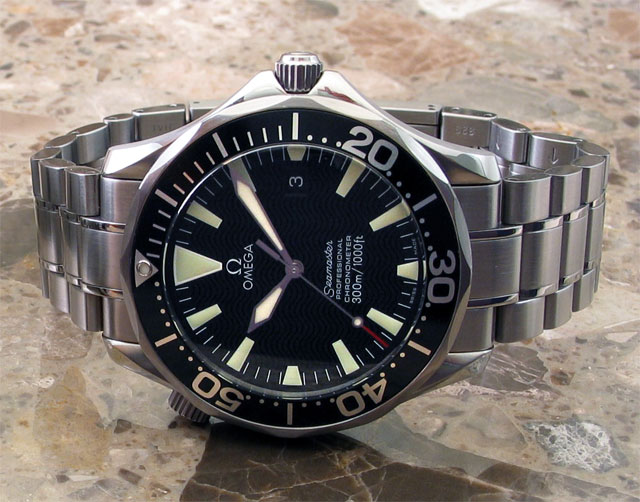
Seamaster: The unidirectional bezel is about the most easily turned which I've ever tried. I can easily grip it, and it has nice "click" sound as you make your way around the dial. The markings on the bezel align perfectly with both the dial markers and hands, and are very legible. I find no flaws here. RATING: 10

Submariner: The unidirectional bezel is about the most easily turned which I've ever tried. I can easily grip it, and it has nice "click" sound as you make your way around the dial. The markings on the bezel align perfectly with both the dial markers and hands, and are very legible. I find no flaws here. RATING: 10
Winner: Yes, my comments are identical for the bezels of both watches. Both would seem to represent the pinnacle of bezel form and function. TIE
DIAL, MARKERS, & HANDS
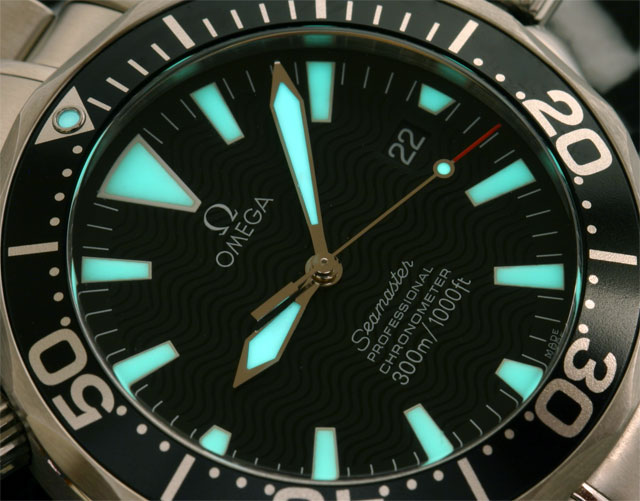
Seamaster: This has to be one of the most legible watches ever. The oversized markers and the large sword hands make for excellent visibility. The luminescent coating on the hands and markers makes this watch the undisputed king of night time glow. The wave pattern on the dial is quite captivating and distinctive. The date, while unmagnified is also easily read. RATING: 10
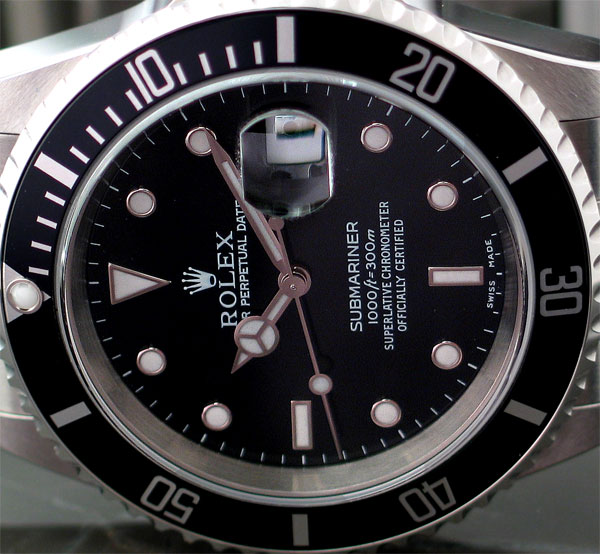
Submariner: The dial of the submariner is a work of art, and perhaps one of the most copied styles in watch history. The Mercedes style hands are a classic. The magnified date seems equally praised and panned - some like it, some don't (perhaps why the Sea Dweller does not have a date magnifier). RATING: 10
WINNER: There seems to be no observable advantage here - liking one or the other might simply be a matter of personal preference, but I like both equally well. TIE
CRYSTAL
Seamaster: Combines sapphire composition with an anti-reflective coating applied to the inside of the crystal for the ultimate in both scratch resistances and visibility. RATING: 10
Submariner: Sapphire crystal used, but no anti-reflective coating is used. Some have indicated that Rolex does indeed plan to incorporate AR coating in the future, the company is notorious for being slow to change. RATING: 9.0
WINNER: Slight edge given to the SMP because of the AR coating: SMP
BRACELET
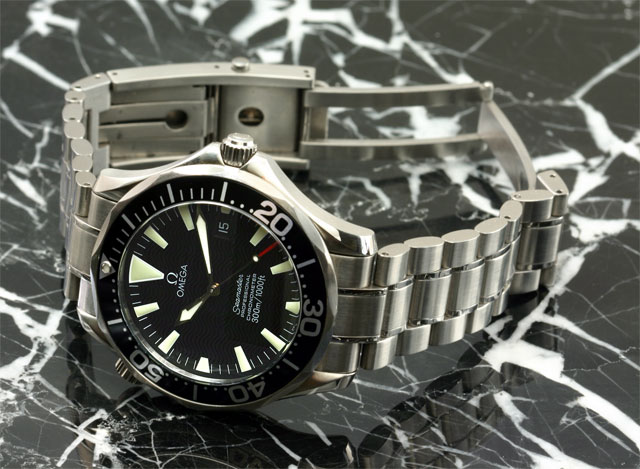
Seamaster: The tapered bracelet feels extremely solid and sturdy. The polished accents on the watch are beautiful, but gives one concern about scratches. The push pin links are not easily adjusted (though not as bad as on the "Bond" bracelet). Solid end links are used, and this bracelet isn't a hair puller. RATING: 7.5
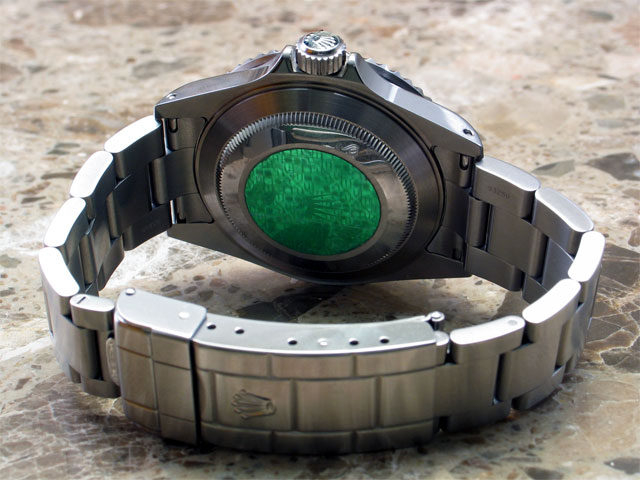
Submariner: The sub bracelet has changed very little over the years. Inexplicably, it has clunky, cheap feel to it. The use of screws in the links makes for easy self-sizing. Brushed finished is both attractive and scratch resistant. Rolex has quite recently (finally) begun using solid end links in the sub bracelet. RATING: 8.5
WINNER: Tough call here - each has obvious strengths and weaknesses. The SMP feels like a higher quality bracelet. The Sub would seem to be a bit less prone to show scratches. Rolex uses a higher grade steel (904) than Omega (316L) in the bracelet. However, I can discern no functional advantage for them to do so in a watch bracelet, and 904 grade steel is approximate 3 times more expensive than 316L. My research indicates 904 grade steel is more commonly used in industrial components which under constant exposure to highly corrosive substances (acids and the like) - conditions which a watch bracelet simply will not be exposed to. Therefore, there is no appreciable benefit to the 904 grade steel in the Rolex bracelet as compared to 316L used in the Omega bracelet. Indeed, no other watch manufacturer uses 904. For ease of sizing and scratch resistance though, this category belongs to Rolex: SUB
CLASP
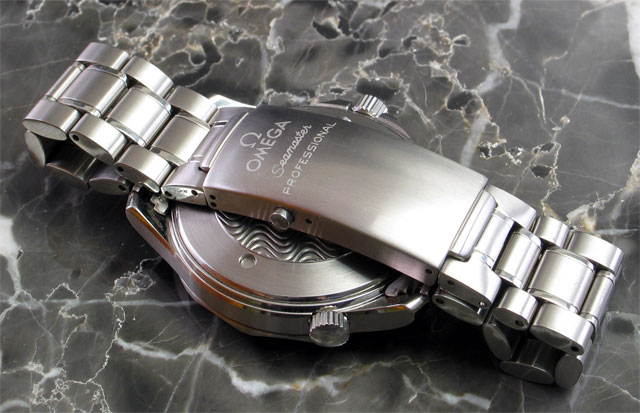
Seamaster: Two-button deployment clasp with integrated diver suit extension. The clasp is easily opened and closed, yet feels extremely sturdy. The diver extension is also easily deployed. The clasp has an extremely high quality feel, and is the best bracelet clasp I have ever used. The large amount of smooth surface area on the bottom of the clasp is reputedly scratch- prone. The clasp also lacks a fine adjustment pin (the bracelet includes a half-sized link for sizing purposes) which some feel detracts from the comfort of the overall bracelet. RATING: 8.5
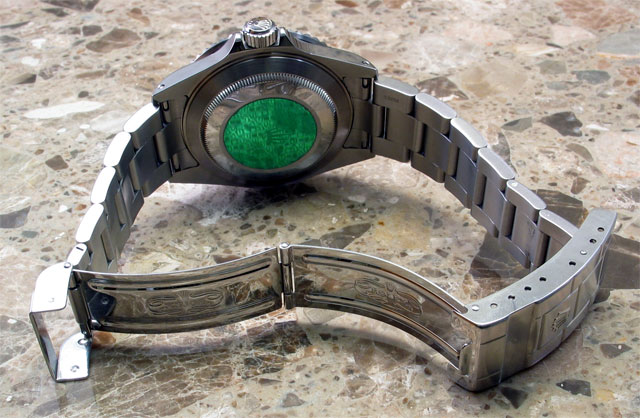
Submariner: The clasp is easily the weakest point on the entire watch. The flip lock clap has been used on Rolex watches for years, and functionally is quite secure. However, the flimsy, thin, stamped sheet metal used in the clasp is simply unacceptable given the price of the watch. Many users (including my friend John who owns this Submariner) report the divers extension is difficult to use. Yes, the clasp does the simple job it was designed to do. No, Rolex has absolutely no motivation to do anything differently based on the sales success. RATING: 7.0
WINNER: No contest here - the Omega clasp is superior in both form and function. SMP
MOVEMENT
Seamaster: The Omega 1120 is a 23 jewel COSC certified movement. Based on the ETA 2892-A2, Omega heavily modifies the 21 jewel base ebauche to produce the beautifully decorated, chronometer grade movement which is the cal. 1120. RATING: 7.0
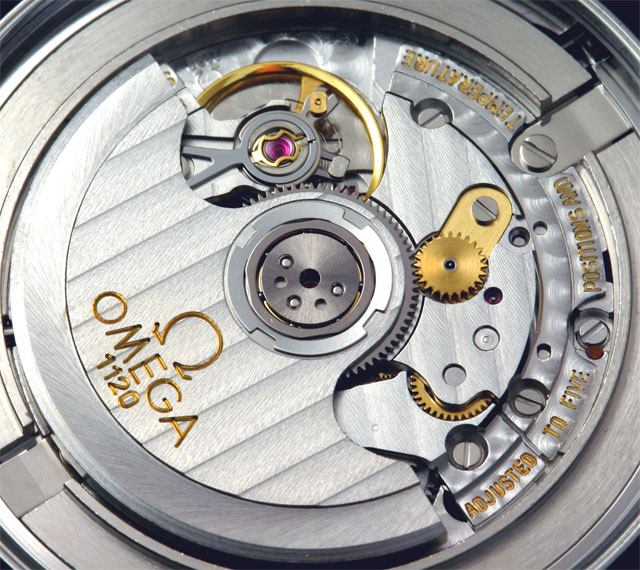
Submariner: The Rolex 3135 movement is a 31 jewel COSC certified, in-house movement that's been a workhorse for Rolex for many years. The 3135 may not be the prettiest movement you'll ever see, but it does the job it was designed to do exceedingly well. RATING: 8.0
WINNER: I've thought about this one long and hard. I've reviewed the available literature and research on the Rolex 3135 as well as the Omega 1120. Both are rock solid, dependable COSC certified movements. The Rolex 3135 does have some advantages. For instance, the 3135 does have a longer power reserve 50 hrs. vs. 44 hrs. for the 1120. Additionally, the 3135 has technically been in existence longer than the 1120. That means Rolex has had longer to refine the production of the 3135 vs. the 1120, and there's likely more spare 3135 parts out there as compared to the 1120. But consider that the 1120 is based on the ETA 2892-A2 - a moment that was introduced in 1975, with a development history going back years earlier to Eterna. This means the 1120 has a lot more going for it in terms of service history and spare parts then one might initially conclude. The nod ultimately goes to the Submariner. SUB.
PACKAGING
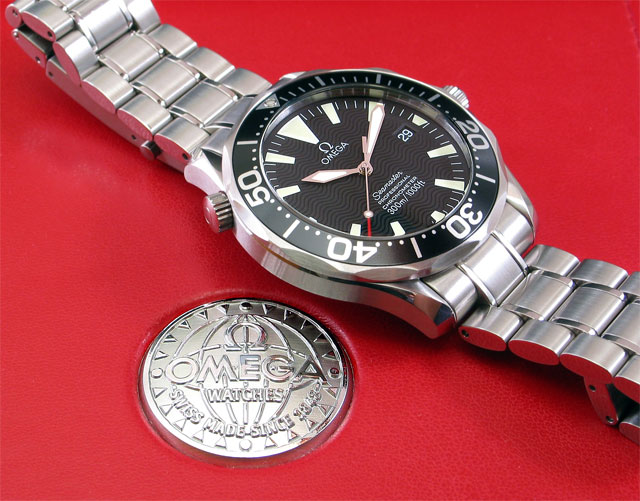
Seamaster: Gorgeous red leather box, hardcover manual, and leather wallet for the warranty card, chronometer certification, and manual key (pictogram card). RATING: 8

Submariner: Classic green leather box, manuals/warranty/chronometer certification, and the infamous silver anchor. RATING: 8
WINNER: Both have very nice packaging, though for the money you pay for each, a nice wood exterior presentation box would be a nice touch (as is the case with the Rolex Daytona, and the Omega Aqua Terra). TIE
PRESTIGE
Seamaster: Omega is an extremely well known, well respected brand, both within and outside watch enthusiast circles. Omega estimates their own brand recognition to be 70% world wide (7 out of every 10 people have heard of Omega watches). Omega marketing works hard to maintain and increase this recognition, and to associate the brand with celebrities and activities which suggest success and achievement. RATING: 8.
Submariner: Rolex may well be the prestige standard by which all other watch brands are measured. Rolex is unequaled in their marketing efforts. Even people who know virtually nothing about watches recognize the Rolex name and associate with it being "the best." No other watch is a greater, more recognizable symbol of status and achievement. RATING: 10
Winner: Rolex is the hands down winner of this category. In fact, many people buy Rolex watches on this basis alone. SUB
PRICE
Seamaster: $1750.00 retail is a lot of money, but the "street" price of this watch can typically see a 30-35% discount off the retail price. When compared to watches in a similar category, the price, at both retail and especially street level, is a relative bargain. Since the current version of the Seamaster has been around less than 10 yrs., long term pricing trends are inconclusive. Well maintained, vintage Omega Seamaster models hold and in some cases appreciate in value. Well maintained current model Seamasters seem to be holding roughly 50% of their retail value at this point. So, one can conclude that if a current model Seamaster is purchased either used or new at street price levels, then one stands to loose very little, if any of the purchase price if the watch is later sold. RATING: 8
Submariner: Three factors contribute to the current retail pricing and future value of Rolex watches. The Rolex policy of continuously, and regularly increasing the retail price is why the Submariner is currently reaching nearly $4000.00. Rolex is tyrannical when it comes to discounting, so it's rare to see a Rolex discounted any more than 10%, if at all. Additionally, Rolex controls production to ensure supply does not exceed demand. Obviously the closer to actual retail price one pays for a Submariner, the longer one will have to hold on to the watch without experiencing a loss when reselling (the asking price of a used Rolex seems to increase in direct proportion to the escalating retail price). But, one does have a better than fair chance of recouping their investment or even making some money if they sell their submariner in the future. There is no empirical reason for the high price of the Submariner, yet Rolex sells every watch they make so they have no reason to alter their pricing policy. RATING: 6
Winner: The SMP is the hands down winner here. You can purchase 2 SMPs for the price of a Sub, and have money left over. SMP.
RESULTS
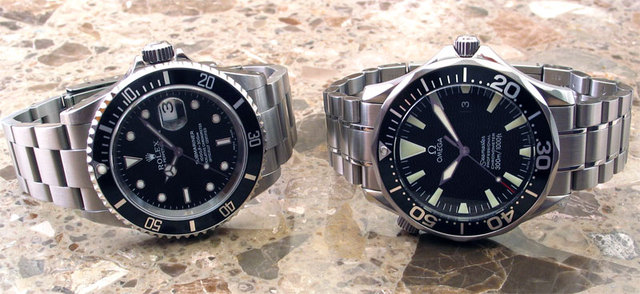
TOTAL POINTS POSSIBLE: 100
SEAMASTER TOTAL POINTS: 87
SUBMARINER TOTAL POINTS: 85.5
TOTAL NUMBER OF CATEGORIES: 10
TOTAL CATEGORIES TIED: 2
TOTAL CATEGORIES SEAMASTER: 4
TOTAL CATEGORIES SUBMARINER: 4
Given that I purchased the Seamaster and not the Submariner, I recognize a degree of inherit bias on my part in evaluating these two watches. No one was more surprised than me at how closely these two scored. Only a point and a half separate the Seamaster from the Submariner, with the SMP getting the highest overall score.
Interestingly enough, in my research for this article, I learned that WatchTime Magazine did a very similar comparison of a titanium Omega Seamaster with a Rolex Submariner in their May/June 2000 issue. The results were very similar - a marginal win, but for the Submariner (solace for those who will undoubtedly be outraged at the notion that anyone would rate Omega higher than Rolex) with a score of 80 to 76.
This experience in doing this article was valuable beyond words. Researching the two companies and these two particular models (each with their own great history and tradition) was truly enriching. My appreciation for both the Seamaster and the Submariner has only grown. Hopefully, yours has as well.
